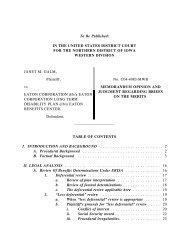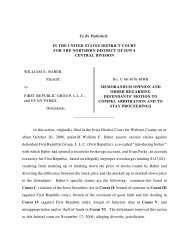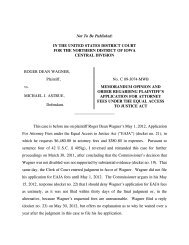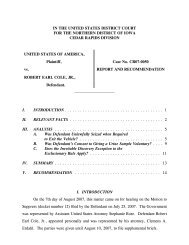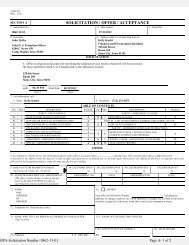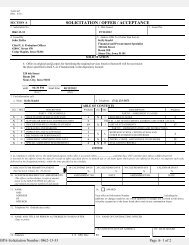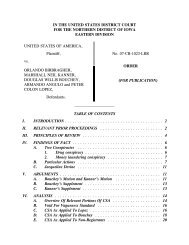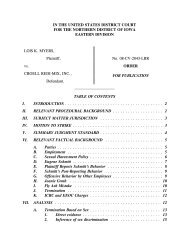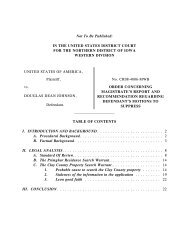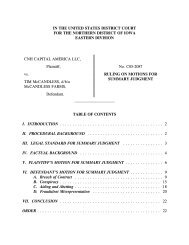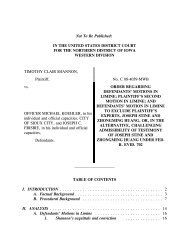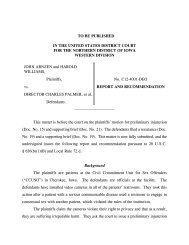Trial Setting Order for Bench Trials - Northern District of Iowa
Trial Setting Order for Bench Trials - Northern District of Iowa
Trial Setting Order for Bench Trials - Northern District of Iowa
Create successful ePaper yourself
Turn your PDF publications into a flip-book with our unique Google optimized e-Paper software.
ORDER SETTING BENCH TRIAL, FINAL PRETRIAL CONFERENCE, AND<br />
REQUIREMENTS FOR THE PROPOSED FINAL PRETRIAL ORDER<br />
IT IS ORDERED: 1<br />
I. TRIAL DATE: This case has been placed on the calendar <strong>of</strong> United States<br />
Chief Magistrate Judge Paul W. Zoss <strong>for</strong> a bench trial scheduled to commence in the [third<br />
floor] [first floor] district courtroom <strong>of</strong> the Federal Courthouse in Sioux City, <strong>Iowa</strong>, during<br />
the two-week period beginning on the ^C day <strong>of</strong> ^C, 200^C.<br />
II.<br />
CONTINUANCE OF TRIAL OR FINAL PRETRIAL CONFERENCE<br />
DATES: Unless requested within 14 days after the date <strong>of</strong> this order, no continuance <strong>of</strong><br />
the trial date will be granted except upon written application and <strong>for</strong> exceptional cause.<br />
III.<br />
FINAL PRETRIAL CONFERENCE: A final pretrial conference (“FPTC”)<br />
is scheduled be<strong>for</strong>e United States Chief Magistrate Judge Paul A. Zoss on the ^C day <strong>of</strong><br />
^C, 200^C. [approximately two weeks be<strong>for</strong>e trial] The FPTC will be held in person at the<br />
U.S. Courthouse in Sioux City, <strong>Iowa</strong>, unless the parties agree in advance to a telephonic<br />
FPTC and so notify Judge Zoss at least two court days be<strong>for</strong>e the FPTC. If the FPTC is<br />
being held by telephone, the court will initiate the conference call, but the parties must<br />
advise the court <strong>of</strong> the contact numbers <strong>for</strong> each party and counsel who will participate in<br />
a telephonic FPTC at least one court day be<strong>for</strong>e the FPTC.<br />
IV.<br />
FINAL PRETRIAL ORDER: The parties are jointly responsible <strong>for</strong> the<br />
preparation <strong>of</strong> the proposed Final Pretrial <strong>Order</strong>. Be<strong>for</strong>e the FPTC, pro se parties and<br />
counsel <strong>for</strong> represented parties must prepare, agree upon, and sign a proposed Final Pretrial<br />
<strong>Order</strong> prepared <strong>for</strong> Judge Zoss’s signature in the <strong>for</strong>mat attached to this order. The<br />
proposed order must not be filed, but must be e-mailed, in WordPerfect or MS Word<br />
<strong>for</strong>mat, to Judge Zoss (paul_zoss@iand.uscourts.gov) at least two court days be<strong>for</strong>e the<br />
1 NOTE: This order was revised as <strong>of</strong> July 8, 2008. The parties are directed to review the<br />
requirements <strong>of</strong> this order carefully, and to comply fully with those requirements.
FPTC. The parties’ exhibit lists, prepared as set <strong>for</strong>th below in this order, must be attached<br />
to the proposed final pretrial order, with the entire order, including the exhibit lists,<br />
constituting a single document.<br />
V. WITNESS AND EXHIBIT LISTS: Exhibit lists must be attached to, and<br />
witness lists must be included as part <strong>of</strong>, the proposed Final Pretrial <strong>Order</strong>, in accordance<br />
with the instructions in the attached <strong>for</strong>m order. The parties are not required to list rebuttal<br />
witnesses or impeachment exhibits. Proposed witness and exhibit lists must be exchanged<br />
by the parties (but not filed) at least 21 days be<strong>for</strong>e the FPTC. At the time the parties<br />
exchange their exhibit lists, they also must give written notice to all adverse parties <strong>of</strong> any<br />
intent to use a declaration under Federal Rules <strong>of</strong> Evidence 803(6), 902(11), or 902(12) to<br />
establish foundation <strong>for</strong> records <strong>of</strong> regularly-conducted activities, and immediately<br />
thereafter they must make the records and the declaration available <strong>for</strong> inspection.<br />
VI.<br />
following instructions:<br />
EXHIBITS: Exhibits must be prepared <strong>for</strong> trial in accordance with the<br />
A. Marking <strong>of</strong> Exhibits. All exhibits must be marked by the parties be<strong>for</strong>e<br />
trial. The plaintiff(s) should use numbers and the defendant(s) should use letters,<br />
unless prior approval is obtained from Judge Zoss <strong>for</strong> a different exhibit<br />
identification scheme. (For example, the parties may want to obtain approval to<br />
utilize a sequential numbering system related to the numbering <strong>of</strong> exhibits as they<br />
were numbered in discovery.) Exhibits also must be marked with the case number.<br />
All exhibits longer than one page must contain page numbers at the bottom <strong>of</strong> each<br />
page.<br />
B. Elimination <strong>of</strong> Duplicates. The parties must compare their exhibits and<br />
eliminate duplicates. If more than one party wants to <strong>of</strong>fer the same exhibit, then<br />
it should be marked with a number and listed as a joint exhibit on the exhibit list <strong>of</strong><br />
the plaintiff(s).<br />
C. Listing <strong>of</strong> Exhibits and Objections. Exhibits must be listed separately,<br />
unless leave <strong>of</strong> court is granted <strong>for</strong> a group exhibit. If a party objects to parts <strong>of</strong> an<br />
exhibit but not to other parts, the <strong>of</strong>fering party must prepare separate versions <strong>of</strong><br />
2
the exhibit, one that includes the parts to which objections are being asserted and the<br />
other that redacts those parts.<br />
D. Exhibits referenced in deposition testimony. All references to<br />
exhibits in deposition testimony that is <strong>of</strong>fered into evidence must correspond<br />
to the exhibit designation <strong>for</strong> trial. The parties are directed to number their<br />
exhibits accordingly.<br />
E. Copies <strong>for</strong> the Court. The parties must bring to the Final Pretrial<br />
Conference trial notebooks containing copies <strong>of</strong> all exhibits to be used at trial. The<br />
court’s copies <strong>of</strong> exhibits should be placed in a ringed binder with a copy <strong>of</strong> the<br />
exhibit list at the front and with each exhibit tabbed and labeled. The parties must<br />
supply the Clerk <strong>of</strong> Court with a second set <strong>of</strong> exhibits, also tabbed and labeled in<br />
a ringed binder, to be used as the original trial exhibits in the <strong>of</strong>ficial records <strong>of</strong> the<br />
court.<br />
VII.<br />
TRIAL BRIEFS: If the trial <strong>of</strong> the case will involve significant issues not<br />
adequately addressed by the parties in connection with dispositive motions or other pretrial<br />
motions, the parties must prepare trial briefs addressing such issues. <strong>Trial</strong> briefs must be<br />
filed at or be<strong>for</strong>e the FPTC, and a copy must be served on any non-ECF counsel and pro<br />
se parties in the case.<br />
VIII. PROTOCOL FOR WITNESSES: An attorney who may call a witness to<br />
testify at trial must, be<strong>for</strong>e the witness testifies, advise the witness <strong>of</strong> the accepted protocol<br />
<strong>for</strong> witnesses testifying in this court. This advice should include the following in<strong>for</strong>mation:<br />
(A) the location <strong>of</strong> the witness box; (B) the proper route from the courtroom door to the<br />
witness box; 2 (C) the fact that the witness will be placed under oath; (D) where the witness<br />
should stand while the oath is being administered; (E) that the witness should adjust the<br />
witness chair and the microphone so the microphone is close to and directly in front <strong>of</strong> the<br />
2 A map displaying this route is attached to this order. A copy <strong>of</strong> this map should be provided to<br />
each witness who is unfamiliar with the layout <strong>of</strong> the courtroom by the attorney calling the witness to<br />
testify.<br />
3
witness’s mouth; (F) that the witness should speak only in response to a question; (G) that<br />
the witness should wait <strong>for</strong> a ruling on any objections be<strong>for</strong>e proceeding to answer a<br />
question; (H) that the witness should answer all questions verbally; and (I) that substances<br />
such as food, beverages, and chewing gum should not be brought into the courtroom.<br />
The attorney also must advise the witness <strong>of</strong> proper dress <strong>for</strong> the courtroom. Proper<br />
dress does not include blue jeans, shorts, overalls, T-shirts, shirts with printed words or<br />
phrases on the front or back, tank tops, or the like. The testimony <strong>of</strong> any party or witness<br />
who appears in court in attire prohibited by this section may be barred.<br />
IX.<br />
RESTRICTIONS ON WITNESSES:<br />
A. Exclusion <strong>of</strong> Witnesses. A witness who may testify at the trial or at an<br />
evidentiary hearing must not be permitted to hear the testimony <strong>of</strong> any other<br />
witnesses be<strong>for</strong>e testifying, and is excluded from the courtroom during the trial or<br />
hearing until after the witness has completed his or her testimony, unless exclusion<br />
<strong>of</strong> the witness is not authorized by Federal Rule <strong>of</strong> Evidence 615 or unless the court<br />
orders otherwise. A witness who is excluded from the courtroom pursuant to this<br />
paragraph also is prohibited from reviewing a verbatim record <strong>of</strong> the testimony <strong>of</strong><br />
other witnesses at the trial or hearing until after the witness has completed his or her<br />
testimony at the trial or evidentiary hearing, unless the court orders otherwise.<br />
B. Restrictions on Communications with Witnesses. Unless the court orders<br />
otherwise, after the commencement <strong>of</strong> the trial or an evidentiary hearing and until<br />
the conclusion <strong>of</strong> the trial or hearing, a witness who may testify at the trial or<br />
hearing is prohibited from communicating with anyone about what has occurred in<br />
the courtroom during the trial or hearing. If the witness does testify at the trial or<br />
hearing, after the witness is tendered <strong>for</strong> cross-examination and until the conclusion<br />
<strong>of</strong> the witness’s testimony, the witness is prohibited from communicating with<br />
anyone about the subject matter <strong>of</strong> the witness’s testimony. A witness may,<br />
however, communicate with his or her attorney about matters <strong>of</strong> privilege, and may<br />
communicate with anyone if the right to do so is guaranteed by the United States<br />
Constitution.<br />
C. Parties. The restrictions on witnesses in paragraphs (A) and (B) <strong>of</strong> this<br />
section do not apply to the parties.<br />
4
D. Duties <strong>of</strong> Counsel. An attorney who may call a witness to testify at<br />
the trial or evidentiary hearing must, be<strong>for</strong>e the trial or hearing, advise the witness<br />
<strong>of</strong> the restrictions in this section.<br />
X. TESTIMONY BY DEPOSITION: With respect to any witness who will<br />
testify by deposition, at least 21 days be<strong>for</strong>e trial, the party intending to <strong>of</strong>fer the witness<br />
must serve on the opposing parties a written designation, by page and line number, <strong>of</strong> those<br />
portions <strong>of</strong> the deposition the <strong>of</strong>fering party intends to have read into evidence. At least<br />
14 days be<strong>for</strong>e trial, any opposing party who objects to the intended testimony must serve<br />
on the <strong>of</strong>fering party any objections to the designated testimony and a counter-designation,<br />
by page and line number, <strong>of</strong> any additional portions <strong>of</strong> the deposition which the opposing<br />
party intends to have read into evidence. At least one week be<strong>for</strong>e trial, the party <strong>of</strong>fering<br />
the witness must serve upon the opposing parties any objections to the designated testimony<br />
and a written designation, by page and line number, <strong>of</strong> any additional portions <strong>of</strong> the<br />
deposition the <strong>of</strong>fering party intends to have read into evidence. At least four court days<br />
be<strong>for</strong>e trial, the parties must consult, either personally or by telephone, and attempt to work<br />
out any objections to the proposed deposition testimony.<br />
At least two court days be<strong>for</strong>e the commencement <strong>of</strong> trial, the party intending to<br />
<strong>of</strong>fer the deposition testimony must provide Judge Zoss with a copy <strong>of</strong> the deposition, with<br />
the parts <strong>of</strong> the deposition to be included in the record clearly indicated on the deposition,<br />
together with a statement listing all unresolved objections. Judge Zoss will review any<br />
objections, listen to any arguments, and make any necessary rulings. The court also will<br />
expect the parties to edit any video deposition accordingly.<br />
All references in depositions to exhibit numbers or letters must correspond to the<br />
exhibit designation <strong>for</strong> trial. The parties are directed to number their exhibits accordingly.<br />
5
XI. MOTIONS IN LIMINE: The parties are required to notify the court by motion<br />
in limine or by motion under Federal Rule <strong>of</strong> Evidence 104(a) <strong>of</strong> any novel, unusual, or<br />
complex legal, factual, or procedural issues reasonably anticipated to arise at trial. All such<br />
motions must be served and filed at least 14 days be<strong>for</strong>e the FPTC. Resistances to such<br />
motions must be served and filed within five court days after service <strong>of</strong> the motion.<br />
XII. OPENING STATEMENTS; CLOSING ARGUMENTS: Opening statements<br />
are limited to 30 minutes and closing arguments are limited to one hour. A request <strong>for</strong><br />
additional time <strong>for</strong> opening statements or closing arguments must be made no later<br />
than the commencement <strong>of</strong> trial.<br />
XIII. SETTLEMENT CONFERENCE: Any party desiring a settlement conference<br />
should contact Judge Zoss in Sioux City, <strong>Iowa</strong>, 712/233-3921, at the earliest opportunity.<br />
Such contact may be ex parte <strong>for</strong> the sole purpose <strong>of</strong> requesting a settlement conference.<br />
A settlement conference will be scheduled with a judge who will not be involved in trying<br />
the case.<br />
IT IS SO ORDERED.<br />
DATED ___ day <strong>of</strong> __________________, 20____.<br />
___________________________________<br />
PAUL A. ZOSS<br />
CHIEF MAGISTRATE JUDGE<br />
UNITED STATES DISTRICT COURT
MAP OF THE THIRD-FLOOR COURTROOM<br />
FEDERAL BUILDING, SIOUX CITY, IOWA
UNITED STATES DISTRICT COURT<br />
IN AND FOR THE NORTHERN DISTRICT OF IOWA<br />
___________ DIVISION<br />
[INSERT PARTIES AND CASE NUMBER]<br />
FINAL PRETRIAL ORDER<br />
[PROPOSED]<br />
[NOTE: Instructions <strong>for</strong> preparing this <strong>for</strong>m appear in brackets and should not be<br />
reproduced in the proposed Final Pretrial <strong>Order</strong>. All material not appearing in brackets<br />
should be reproduced in the proposed Final Pretrial <strong>Order</strong>, as applicable.]<br />
This final pretrial order was entered after a final pretrial conference held on [date].<br />
The court expects the parties to comply fully with this order. [Full compliance with the<br />
order will assist the parties in preparation <strong>for</strong> trial, shorten the length <strong>of</strong> trial, and improve<br />
the quality <strong>of</strong> the trial. Full compliance with this order also will help “secure the just,<br />
speedy, and inexpensive determination” <strong>of</strong> the case. Fed. R. Civ. P. 1.]<br />
The following counsel, who will try the case, appeared at the conference [Except in<br />
the case <strong>of</strong> attorneys at the same firm, list each attorney’s in<strong>for</strong>mation separately. Include<br />
an e-mail address <strong>for</strong> each attorney who will try the case.]:<br />
1. For plaintiff(s):<br />
Name(s)<br />
Street Number, Street Name and/or Box Number<br />
City, State and Zip Code<br />
Phone Number [include area code]<br />
Facsimile Number [include area code]<br />
E-mail address<br />
2. For defendant(s):<br />
Name(s)<br />
Street Number, Street Name and/or Box Number<br />
City, State and Zip Code<br />
Phone Number [include area code]<br />
Facsimile Number [include area code]<br />
E-mail address
I. STIPULATIONS OF FACT: The parties agree that the following facts are true and<br />
undisputed: [The parties are to recite all material facts as to which there is no dispute.<br />
Special consideration should be given to such things, <strong>for</strong> example, as life and work<br />
expectancy, medical and hospital bills, funeral expenses, cause <strong>of</strong> death, lost wages, back<br />
pay, the economic value <strong>of</strong> fringe benefits, and property damage. The parties should<br />
stipulate to an undisputed fact even if the legal relevance <strong>of</strong> the stipulated fact is questioned<br />
by one or more party, but in such instances the stipulated fact should be followed by an<br />
identification <strong>of</strong> the objecting party and the objection (e.g. “Plaintiff objects to<br />
relevance.”)]<br />
A.<br />
B.<br />
II. EXHIBIT LIST: The parties’ exhibit lists are attached to this <strong>Order</strong>. [The parties<br />
are to attach to this order (not include in the body <strong>of</strong> the order) exhibit lists that include all<br />
exhibits (except <strong>for</strong> impeachment exhibits) each party intends to <strong>of</strong>fer into evidence at trial.<br />
Exhibit lists are to be prepared in the attached <strong>for</strong>mat, indicating objections using the<br />
categories described in the <strong>for</strong>m.<br />
All exhibits are to be made available to opposing counsel <strong>for</strong> inspection at least<br />
twenty-one days be<strong>for</strong>e the date <strong>of</strong> the FPTC. Failure to provide an exhibit <strong>for</strong> inspection<br />
constitutes a valid ground <strong>for</strong> objection to the exhibit, and should be noted on the exhibit<br />
list. Any exhibit not listed on the attached exhibit list is subject to exclusion at trial. The<br />
court may deem any objection not stated on the attached exhibit list as waived.<br />
The parties must bring to the Final Pretrial Conference trial notebooks containing<br />
copies <strong>of</strong> all exhibits to be used at trial. The court’s copies <strong>of</strong> exhibits should be placed in<br />
a ringed binder with a copy <strong>of</strong> the exhibit list at the front and with each exhibit tabbed. The<br />
parties must supply the Clerk <strong>of</strong> Court with a second set <strong>of</strong> exhibits, also tabbed and in a<br />
ringed binder, to be used as the original trial exhibits in the <strong>of</strong>ficial records <strong>of</strong> the court.]<br />
III. WITNESS LIST: The parties intend to call the following witnesses at trial: [Each<br />
party must prepare a witness list, in the following <strong>for</strong>mat, that includes all witnesses (except<br />
<strong>for</strong> rebuttal witnesses) the party intends to call to testify at trial. The parties are to<br />
exchange their separate witness lists at least twenty-one days be<strong>for</strong>e the date <strong>of</strong> the FPTC.<br />
2
A witness testifying by deposition must be listed in the witness list with a designation that<br />
the testimony will be by deposition.]<br />
A. Plaintiff(’s)(s’) witnesses [list name, substance <strong>of</strong> testimony, whether any<br />
party objects to the witness, and the nature <strong>of</strong> and grounds <strong>for</strong> any objection]:<br />
1.<br />
2.<br />
B. Defendant(’s(s’)) witnesses [list name, substance <strong>of</strong> testimony, whether any<br />
party objects to the witness, and the nature <strong>of</strong> and grounds <strong>for</strong> any objection]:<br />
1.<br />
2.<br />
All parties are free to call any witness listed by an opposing party. A party listing<br />
a witness guarantees his or her presence at trial unless it is indicated otherwise on the<br />
witness list. Any objection to the <strong>of</strong>fer <strong>of</strong> testimony from a witness on the witness list is<br />
waived if it is not stated on this list.<br />
IV. RESTRICTIONS ON WITNESSES: A witness who may testify at the trial<br />
or at an evidentiary hearing must not be permitted to hear the testimony <strong>of</strong> any other<br />
witnesses be<strong>for</strong>e testifying, and is excluded from the courtroom during the trial or hearing<br />
until after the witness has completed his or her testimony, unless exclusion <strong>of</strong> the witness<br />
is not authorized by Federal Rule <strong>of</strong> Evidence 615 or unless the court orders otherwise.<br />
A witness who is excluded from the courtroom pursuant to this paragraph also is prohibited<br />
from reviewing a verbatim record <strong>of</strong> the testimony <strong>of</strong> other witnesses at the trial or hearing<br />
until after the witness has completed his or her testimony at the trial or evidentiary hearing,<br />
unless the court orders otherwise.<br />
Unless the court orders otherwise, after the commencement <strong>of</strong> the trial or an<br />
evidentiary hearing and until the conclusion <strong>of</strong> the trial or hearing, a witness who may<br />
testify at the trial or hearing is prohibited from communicating with anyone about what has<br />
occurred in the courtroom during the trial or hearing. If the witness does testify at the trial<br />
or hearing, after the witness is tendered <strong>for</strong> cross-examination and until the conclusion <strong>of</strong><br />
the witness’s testimony, the witness is prohibited from communicating with anyone about<br />
the subject matter <strong>of</strong> the witness’s testimony. A witness may, however, communicate with<br />
his or her attorney about matters <strong>of</strong> privilege, and may communicate with anyone if the<br />
right to do so is guaranteed by the United States Constitution.<br />
These prohibitions do not apply to the parties. An attorney who may call a witness<br />
to testify at trial must, be<strong>for</strong>e the trial, advise the witness <strong>of</strong> these restrictions.<br />
3
V. EVIDENTIARY AND OTHER LEGAL ISSUES:<br />
A. Plaintiff(‘s)(s’) Issues:<br />
1.<br />
2.<br />
B. Defendant(‘s)(s’) Issues:<br />
1.<br />
2.<br />
[The parties must list all unusual evidentiary and legal issues that are likely to arise at trial,<br />
including such things as disputes concerning the admissibility <strong>of</strong> evidence or testimony<br />
under the Federal Rules <strong>of</strong> Evidence; the elements <strong>of</strong> a cause <strong>of</strong> action; whether recovery<br />
is barred as a matter <strong>of</strong> law by a particular defense; disputes concerning the measure,<br />
elements, or recovery <strong>of</strong> damages; and whether the Statute <strong>of</strong> Frauds or the Parol Evidence<br />
Rule will be raised. The purpose <strong>of</strong> this listing <strong>of</strong> issues is to advise the court in advance<br />
<strong>of</strong> issues and problems that might arise at trial.]<br />
VI. COURTROOM TECHNOLOGY: Prior to trial, attorneys and witnesses who intend<br />
to utilize the technology available in the courtroom must familiarize themselves with the<br />
proper manner <strong>of</strong> operation <strong>of</strong> the equipment. Instruction and training on the proper use<br />
<strong>of</strong> the equipment may be obtained at a training session set up by prior appointment with<br />
Jose Leon, who may be contacted at 712-233-3845. (If the parties are unable to reach Jose<br />
Leon, they may call Sue Young, at 712-233-3844.)<br />
VII. OPENING STATEMENTS; CLOSING ARGUMENTS: Opening statements are<br />
limited to 30 minutes and closing arguments are limited to one hour. A request <strong>for</strong><br />
additional time <strong>for</strong> opening statements or closing arguments must be made no later<br />
than the commencement <strong>of</strong> trial.<br />
VIII. PROTOCOL FOR WITNESSES: An attorney who may call a witness to testify<br />
at trial must, be<strong>for</strong>e the witness testifies, advise the witness <strong>of</strong> the accepted protocol <strong>for</strong><br />
witnesses testifying in this court. This advice should include the following in<strong>for</strong>mation:<br />
(A) the location <strong>of</strong> the witness box; (B) the proper route from the courtroom door to the<br />
witness box; (C) the fact that the witness will be placed under oath; (D) where the witness<br />
should stand while the oath is being administered; (E) that the witness should adjust the<br />
witness chair and the microphone so the microphone is close to and directly in front <strong>of</strong> the<br />
4
witness’s mouth; (F) that the witness should speak only in response to a question; (G) that<br />
the witness should wait <strong>for</strong> a ruling on any objections be<strong>for</strong>e proceeding to answer a<br />
question; (H) that the witness should answer all questions verbally; and (I) that substances<br />
such as food, beverages, and chewing gum should not be brought into the courtroom.<br />
The attorney also must advise the witness <strong>of</strong> proper dress <strong>for</strong> the courtroom. Proper<br />
dress does not include blue jeans, shorts, overalls, T-shirts, shirts with printed words or<br />
phrases on the front or back, tank tops, or the like. The testimony <strong>of</strong> any party or witness<br />
who appears in court in attire prohibited by this section may be barred.<br />
IT IS SO ORDERED.<br />
DATED this _____ day <strong>of</strong> ___________________, 20____.<br />
_____________________________________________<br />
PAUL A. ZOSS<br />
CHIEF MAGISTRATE JUDGE<br />
UNITED STATES DISTRICT COURT<br />
5
(PLAINTIFF’S) (PLAINTIFFS’) (DEFENDANT’S) (DEFENDANTS’) EXHIBIT LIST<br />
[Form]<br />
The following categories have been used <strong>for</strong> objections to exhibits:<br />
A. Category A. These exhibits already will be in evidence at the commencement<br />
<strong>of</strong> the trial, and will be available <strong>for</strong> use by any party at any stage <strong>of</strong> the<br />
proceedings without further <strong>of</strong>fer, pro<strong>of</strong>, or objection.<br />
B. Category B. These exhibits are objected to on grounds other than<br />
foundation, identification, or authenticity. This category has been used <strong>for</strong><br />
objections such as hearsay or relevance.<br />
C. Category C. These exhibits are objected to on grounds <strong>of</strong> foundation,<br />
identification, or authenticity. This category has not been used <strong>for</strong> other<br />
grounds, such as hearsay or relevance.<br />
(Plaintiff’s)(Plaintiffs’)<br />
(Defendant’s)(Defendants’)<br />
Exhibits<br />
Objections<br />
[Cite Fed. R. Evid.]<br />
Category<br />
A, B, C Offered<br />
Admit/Not<br />
Admitted<br />
(A) - (NA)<br />
1. [describe exhibit] *<br />
2. [describe exhibit]<br />
3. [describe exhibit]<br />
4. [describe exhibit]<br />
5. [describe exhibit]<br />
[*This column is <strong>for</strong> use by the trial judge at trial. Nothing should be entered in this<br />
column by the parties.]<br />
6



